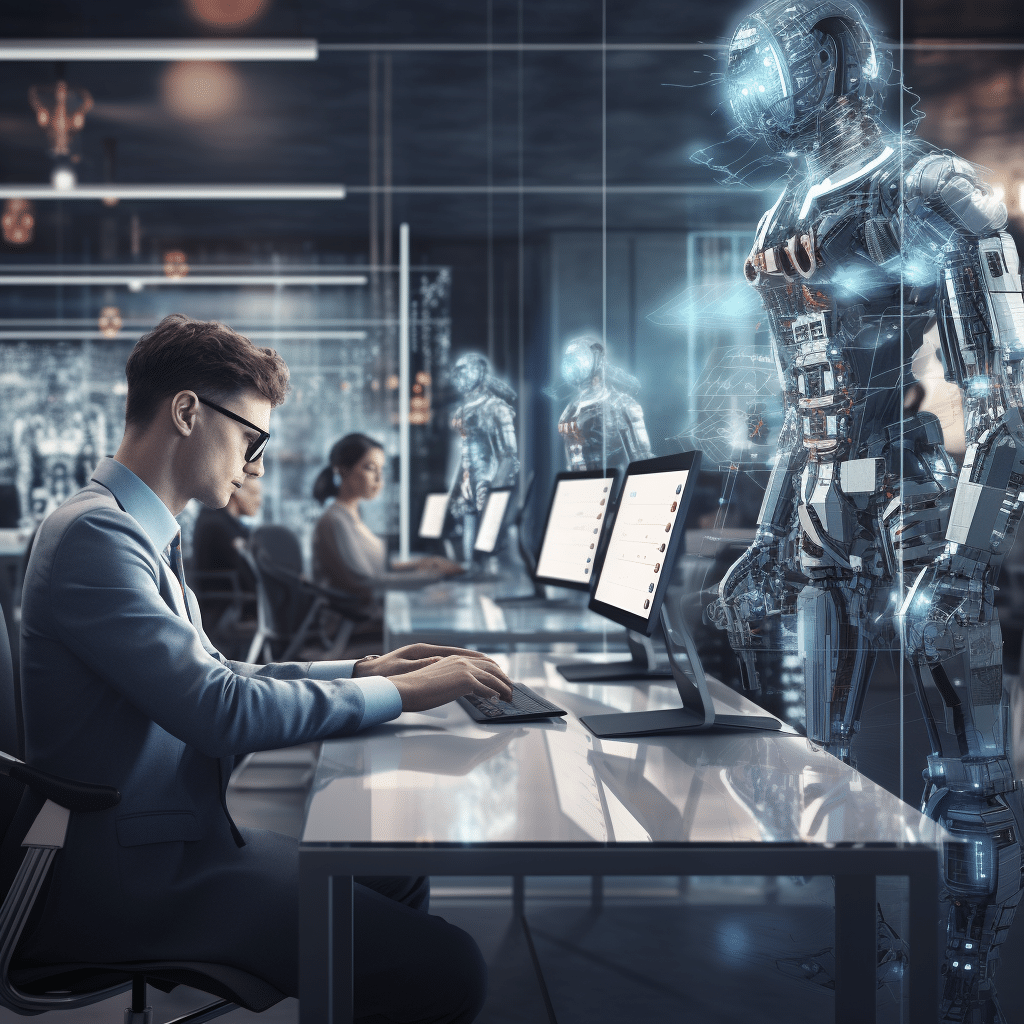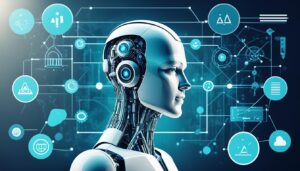
AI and Workplace Communication: Bridging Gaps
In today’s fast-paced digital world, effective communication in the workplace is more important than ever. However, many organizations struggle with communication gaps that hinder productivity and collaboration among team members. This is where AI (Artificial Intelligence) comes into play, acting as a bridge to enhance workplace communication
The Role of AI in Workplace Communication
AI technology has evolved to become a powerful tool in improving workplace communication. It helps organizations streamline processes, automate repetitive tasks, and provide intelligent solutions to various challenges. Here are some ways AI is bridging communication gaps:
1. Enhanced Language Processing
Language barriers can impede effective communication, especially in multinational companies. AI-powered language processing tools enable real-time translation, transcription, and interpretation, minimizing misunderstandings and fostering collaboration among diverse teams. Such tools support seamless communication across different languages, making remote and international collaborations smoother.
2. Voice Assistants and Chatbots
Voice assistants and chatbots have become increasingly popular in the workplace. They serve as virtual assistants, ready to help employees with inquiries, scheduling, reminders, and more. These AI-powered interfaces enable quick and easy communication, freeing up time for employees to focus on more complex tasks. Additionally, chatbots can provide instant support and guidance to team members, resolving common issues and delivering consistent information.
“AI-powered tools have revolutionized workplace communication by breaking down language barriers and improving overall efficiency.”
3. Smart Scheduling and Meeting Assistants
Scheduling meetings and coordinating calendars can be a time-consuming process. AI-powered assistants can analyze employees’ calendars, availability, and priorities to schedule meetings efficiently. These assistants also help manage meeting logistics, sending reminders and agenda updates to all participants. By reducing the administrative burden, these tools promote effective communication and enable teams to collaborate seamlessly.
4. Sentiment Analysis
Understanding the sentiment behind communications is crucial for effective workplace collaboration. AI technology can analyze written and spoken language, detecting emotions and tones in messages. Sentiment analysis tools can identify potential conflicts, stress levels, or instances where clarification might be needed. This insight allows organizations to address concerns promptly and prevent potential misunderstandings, improving overall communication and team dynamics.
The Future of AI in Workplace Communication

As AI technology continues to advance, the future of workplace communication looks promising. Here are some potential developments:
1. Contextual Understanding
Future AI systems may possess advanced contextual understanding capabilities. They could interpret unstructured data seamlessly, contextualize information effectively, and respond with greater accuracy. This level of AI comprehension would significantly enhance workplace communication by providing more nuanced and personalized responses.
2. Virtual Collaboration Spaces
Imagine virtual collaborative workspaces where AI provides real-time suggestions, monitors conversations, and assists with brainstorming sessions. These AI-driven virtual environments could facilitate creative collaboration and streamline communication, regardless of team members’ physical locations.
3. Personalized Communication Assessments
AI tools may offer personalized communication assessments, helping individuals understand their communication patterns, strengths, and areas for improvement. Such assessments could provide valuable insights to enhance workplace communication skills, promoting professional growth and fostering stronger team dynamics
AI has already started revolutionizing workplace communication, and its potential is limitless. By breaking down language barriers, automating tasks, and improving overall efficiency, AI bridges gaps and connects employees on a global scale. Embracing AI technology empowers organizations to foster better collaboration, increase productivity, and achieve their goals in the modern workplace.
How is artificial intelligence being used to enhance workplace communication and bridge gaps between employees?
Artificial intelligence (AI) is being used in various ways to enhance workplace communication and bridge gaps between employees. Here are a few examples:
1. Chatbots:
AI-powered chatbots can provide quick responses to employee queries, reducing the need for manual intervention. These chatbots can handle routine inquiries, provide information, and even assist in onboarding processes.
2. Natural Language Processing (NLP):
NLP techniques allow AI systems to understand and interpret human language. This enables AI assistants to better comprehend written or spoken communication, aiding employees in finding relevant information faster and improving collaboration across teams.
3. Language Translation:
AI-powered language translation tools break down language barriers and facilitate communication between employees who speak different languages. These tools can instantly translate written or spoken content, promoting inclusivity and enabling seamless global collaboration.
4. Virtual Meetings:
AI technology is enhancing virtual meetings by providing features such as real-time language translation, transcription, and summarization. This helps participants understand discussions, ensures everyone is on the same page, and makes meetings more efficient.
5. Sentiment Analysis:
AI algorithms can analyze employee feedback and sentiment in emails, chats, or surveys. By understanding the emotions expressed by employees, organizations can identify opportunities for improvement, address concerns, and enhance employee satisfaction and engagement.
6. Personalized Communication:
AI algorithms can analyze individual preferences, communication patterns, and content relevance to personalize communication within the workplace. This can include tailoring email recommendations, suggesting relevant documents, or customizing content in company newsletters, ultimately promoting more effective and targeted communication.
7. Collaboration Tools:
AI-powered collaboration tools assist employees by organizing tasks, managing deadlines, and suggesting team members who should be involved in specific projects. These tools leverage AI algorithms to optimize workflows and streamline communication, thereby bridging gaps between employees working on different projects.
Overall, AI is revolutionizing workplace communication by enabling faster, more accurate, and personalized interactions, thereby fostering a collaborative and inclusive environment.
How can organizations ensure a smooth transition when introducing AI-based communication tools to their workforce, and what strategies can they employ to maximize employee acceptance and engagement

Introducing AI-based communication tools to the workforce can bring significant benefits, but ensuring a smooth transition and maximizing employee acceptance and engagement requires careful planning and execution. Here are some strategies organizations can employ:
1. Clear communication:
Transparently communicate the purpose and benefits of AI-based communication tools to employees. Address any concerns they may have and highlight how these tools can enhance their work experience.
2. Training and education:
Provide comprehensive training programs to familiarize employees with the AI tools and their functionalities. Offer workshops, webinars, and hands-on sessions to ensure employees understand how to effectively use these tools.
3. Pilot testing:
Before rolling out AI-based communication tools across the entire organization, conduct small-scale pilot tests. Gather feedback from a group of employees and use their suggestions to fine-tune the implementation process.
4. Employee involvement:
Involve employees in the decision-making process and actively seek their input. This helps generate a sense of ownership and fosters a collaborative environment where employees feel valued.
5. Customization and personalization:
Allow employees to tailor the AI tools to their needs. Provide options for personalization and customization so that employees can adapt the tools to fit their individual work preferences.
6. Address concerns and provide support:
Proactively address any concerns or fears employees may have regarding job security, privacy, or reduced human interaction. Clearly communicate the role of AI tools as augmenting human capabilities rather than replacing jobs.
7. Continuous feedback loop:
Establish channels for employees to provide ongoing feedback and suggestions regarding the AI tools. Regularly assess the user experience and make iterative improvements based on employee input.
8. Highlight success stories:
Share success stories of how AI-based communication tools have positively impacted other teams or departments within the organization. Use these stories to build confidence and motivate employees to embrace the tools.
9. Recognize and reward adoption:
Provide recognition and rewards for employees who effectively incorporate AI tools into their work and demonstrate high levels of engagement. This encourages others to follow suit and fosters a culture of embracing technological advancements.
10. Constant evaluation and improvement:
Continuously evaluate the effectiveness of the AI-based communication tools and monitor employee satisfaction and engagement levels. Incorporate improvements based on feedback and emerging needs to ensure long-term success.
By employing these strategies, organizations can navigate the transition to AI-based communication tools successfully and promote employee acceptance and engagement, leading to increased productivity and efficiency.








